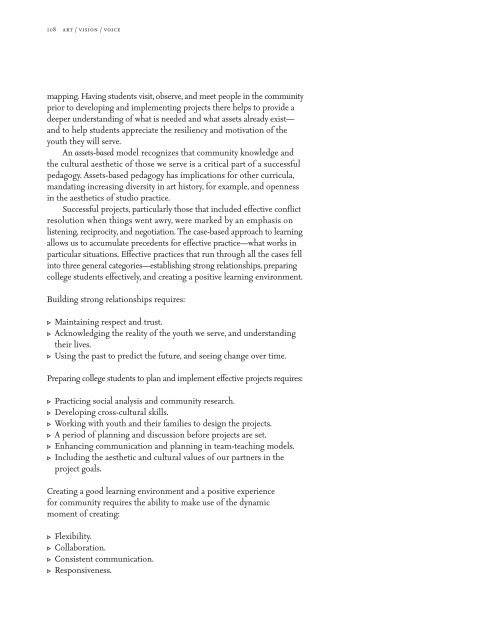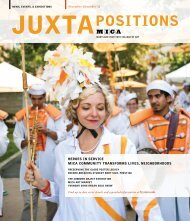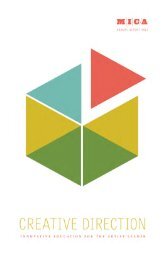art/vision/voice - Maryland Institute College of Art
art/vision/voice - Maryland Institute College of Art
art/vision/voice - Maryland Institute College of Art
You also want an ePaper? Increase the reach of your titles
YUMPU automatically turns print PDFs into web optimized ePapers that Google loves.
108 <strong>art</strong> / <strong>vision</strong> / <strong>voice</strong><br />
mapping. Having students visit, observe, and meet people in the community<br />
prior to developing and implementing projects there helps to provide a<br />
deeper understanding <strong>of</strong> what is needed and what assets already exist—<br />
and to help students appreciate the resiliency and motivation <strong>of</strong> the<br />
youth they will serve.<br />
An assets-based model recognizes that community knowledge and<br />
the cultural aesthetic <strong>of</strong> those we serve is a critical p<strong>art</strong> <strong>of</strong> a successful<br />
pedagogy. Assets-based pedagogy has implications for other curricula,<br />
mandating increasing diversity in <strong>art</strong> history, for example, and openness<br />
in the aesthetics <strong>of</strong> studio practice.<br />
Successful projects, p<strong>art</strong>icularly those that included effective conflict<br />
resolution when things went awry, were marked by an emphasis on<br />
listening, reciprocity, and negotiation. The case-based approach to learning<br />
allows us to accumulate precedents for effective practice—what works in<br />
p<strong>art</strong>icular situations. Effective practices that run through all the cases fell<br />
into three general categories—establishing strong relationships, preparing<br />
college students effectively, and creating a positive learning environment.<br />
Building strong relationships requires:<br />
v Maintaining respect and trust.<br />
v Acknowledging the reality <strong>of</strong> the youth we serve, and understanding<br />
their lives.<br />
v Using the past to predict the future, and seeing change over time.<br />
Preparing college students to plan and implement effective projects requires:<br />
v Practicing social analysis and community research.<br />
v Developing cross-cultural skills.<br />
v Working with youth and their families to design the projects.<br />
v A period <strong>of</strong> planning and discussion before projects are set.<br />
v Enhancing communication and planning in team-teaching models.<br />
v Including the aesthetic and cultural values <strong>of</strong> our p<strong>art</strong>ners in the<br />
project goals.<br />
Creating a good learning environment and a positive experience<br />
for community requires the ability to make use <strong>of</strong> the dynamic<br />
moment <strong>of</strong> creating:<br />
v Flexibility.<br />
v Collaboration.<br />
v Consistent communication.<br />
v Responsiveness.
















